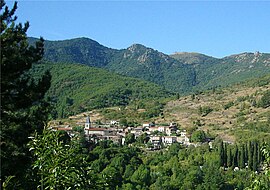Arrigas
Arrigas | |
|---|---|
 A general view of Arrigas | |
| Coordinates: 43°59′24″N 3°28′52″E / 43.99°N 3.4811°E | |
| Country | France |
| Region | Occitania |
| Department | Gard |
| Arrondissement | Le Vigan |
| Canton | Le Vigan |
| Intercommunality | CC Pays Viganais |
| Government | |
| • Mayor (2020–2026) | Régis Bayle[1] |
| Area 1 | 20.28 km2 (7.83 sq mi) |
| Population (2021)[2] | 213 |
| • Density | 11/km2 (27/sq mi) |
| Time zone | UTC+01:00 (CET) |
| • Summer (DST) | UTC+02:00 (CEST) |
| INSEE/Postal code | 30017 /30770 |
| Elevation | 339–1,414 m (1,112–4,639 ft) (avg. 500 m or 1,600 ft) |
| 1 French Land Register data, which excludes lakes, ponds, glaciers > 1 km2 (0.386 sq mi or 247 acres) and river estuaries. | |
Arrigas is a commune in the Gard department in southern France.
Geography[edit]
The village is in the Cévennes, above the D999 road between Le Vigan and Alzon.
History[edit]
Arrigas possesses a number of Megalithic remains including the dolmen of Arrigas on the route to Peyraube, and the dolmen of Peyre Cabussélado near the border with the commune of Arre. There are also three knocked-over menhirs at the mountain pass de Vernes, and more lower down at the place called Troulhas.
The village itself was founded in the 12th century by a colony of Benedictine monks under the dependency of St Victor of Marseille; a church is mentioned in 1113 and a monastery in 1135. By the 14th century, during the Hundred Years' War, the church was fortified.
During the French Wars of Religion the d'Albignac family, lords (seigneurs) of Arrigas, embraced the Reformation, alongside part of the population. But later their loyalty to the Crown led the d'Albignacs to change camp. In 1625, when Henri, duc de Rohan led the uprising of the Protestants of Languedoc, Charles d'Albignac took up the Catholic cause of the King, Louis XIII.
His castle at the Pont d'Arre was taken by the Protestant zealots, while the fortified church of Arrigas was almost completely destroyed. Some months later, at the Siege of Creissels, Charles d'Albignac stopped the advance of the troops of Rohan, and afterwards he was elevated by the King to become the Baron d'Arre.
After the destruction of the Pont d'Arre, the d'Albignac family built the château of Arrigas. Louis-Alexandre d'Albignac was born here in 1739 and became a Lieutenant-General in the armies of the King, then a général de division in the Revolutionary and Imperial armies, decorated with the royal Order of Saint Louis and the Imperial Légion d'honneur.
After a remarkable career under the Ancien Régime, d'Albignac put himself in the service of the French Revolution and accepted becoming the first mayor of Le Vigan (the main town of the region) in 1790. He took up service against the enemies of the Revolution in the Camp of Jales, and then served in the army, either the armies of the Alps or the Rhine. He is the most illustrious of the children of Arrigas, although he died in his own house in Le Vigan in 1825.
Arrigas is lively village from July to August when home owners from all over France, Europe and even Canada descend to spend the summer holidays. There are communal (3 day) fetes in mid July and at the end of August. A little cooler because of its mountain location it provides a welcome break from the fierce heat of the coastal regions of Languedoc.
Population[edit]
| Year | Pop. | ±% |
|---|---|---|
| 1962 | 187 | — |
| 1968 | 234 | +25.1% |
| 1975 | 199 | −15.0% |
| 1982 | 187 | −6.0% |
| 1990 | 175 | −6.4% |
| 1999 | 194 | +10.9% |
| 2008 | 191 | −1.5% |
| 2015 | 214 | +12.0% |
See also[edit]
- Estelle, a hamlet located on the territory of the commune
- Communes of the Gard department
References[edit]
- ^ "Répertoire national des élus: les maires". data.gouv.fr, Plateforme ouverte des données publiques françaises (in French). 2 December 2020.
- ^ "Populations légales 2021". The National Institute of Statistics and Economic Studies. 28 December 2023.




